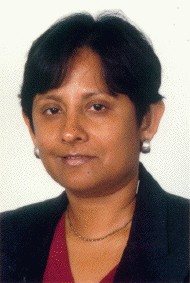Personal tools
News from ICTP 112 - Profile

Former ICTP Associate Anita Mehta leads a life of a 'renaissance' scientist examining big issues with imagination and vigour.
Science in Sandpiles

She refers to herself as an 'expert
dilettante.'
But the truth is that ICTP Associate (1999-2004) Anita Mehta
is an 'expert expert.' Today, she is recognised as one of the
world's foremost statistical physicists, having earned an international
reputation for her pioneering work in the physics of granular
media. Mehta's accomplishments were recently acknowledged in India
when she was named the 2004 Stree Shakti Woman Scientist by a
panel of eminent Indian scientists.
Mehta, who earned her bachelor of sciences degree from Presidency
College in Kolkata and her master's and doctorate degrees from
Oxford University, where she was a Rhodes Scholar, has applied
her knowledge and skills as a postdoctoral consultant at IBM in
New York, a research associate at Cambridge University and visiting
fellow at Oxford University, UK, and a research associate at IRC
for Advanced Materials in Birmingham, UK. She is currently an
associate professor with the statistical and soft condensed matter
physics group at the S.N. Bose National Centre for Basic Sciences
in Kolkata. Her global travels have brought her to ICTP on more
than 10 occasions and, in 2001, she served as director of the
ICTP Research Workshop on Challenges in Granular Physics.
"I would say that my most noteworthy work has focused on
the behaviour and structure of sandpiles," explains Mehta,
"which is far more complicated than you might imagine."
"Think of a pyramid-like sandpile, which is capable of retaining
its shape for long periods, yet can be misshapen---indeed flattened---by
the lightest of touches."
Whether a sandpile remains stable, she maintains, has less to
do with material than with the structure and what she calls 'the
sandpile's dynamical history.' "Sandpiles," she insists,
"have memory!"
Mehta, with her collaborators, has used statistical physics to
learn more about the 'memory' of sandpiles and to build models
that can explain, and sometimes predict, their behaviour.
"What I've been able to learn has applications far beyond
the sandpiles themselves."
The knowledge and skills she has acquired, for example, have led
her to work closely with cosmologists on issues related to the
evolution of primordial black holes; with economists on game theory;
and with polymer physicists on issues related to entanglement.
In fact, her diverse research agenda has ranged from the whimsical
(investigating the way in which a ball bounces on a vibrating
platform) to the deadly serious (how to assure the structural
integrity of bridges and building arches). Her resume, while largely
academic, shows her links with such large multinational corporations
as IBM, Exxon-Mobil, Schlumberger and Unilever. And her academic
activities, in addition to her research, include organising a
conference on the Anatomy of Laughter at Oxford University.
"I find my research to be fascinating on two counts,"
says Mehta. "First, as a statistical physicist I bring a
set of tools to problems spanning the full spectrum of scientific
disciplines---biology, chemistry, physics and engineering. As
a result, my work as a collaborative scientist bears little resemblance
to the public perception of a solitary scientist labouring alone
in a laboratory. And second, because the tools that I use are
designed to help shed light on the behaviour of large and complex
systems, I often have an opportunity to investigate large, challenging
problems."
That not only suits Mehta's education and training but her temperament
as well. Beyond her expertise as a scientist, Mehta is an accomplished
classical pianist who has performed at public concerts, and a
skilled writer who has penned a novel and published articles and
short stories in newspapers and magazines both in India and abroad.
"The 'big picture' science that I do," Mehta notes,
"allows me to draw on my inspiration as well as the methodologies
and skills that I have been taught. That, in turn, enables me
to tap both the left (logical) and right (intuitive) sides of
my brain. It is this duality that makes my work both exciting
and personally rewarding."
Or, as Mehta also likes to say: "I enjoy doing science both
at the frontier of knowledge and the edge of disciplines."
And that ironically has often brought her back to the science
in sandpiles.